Project WOW...
Thanks to the GlaxoSmithKline Foundation and project partners, The Water of Waccamaw “WOW” project will bring the local Waccamaw water shed into middle and high schools in Columbus and Brunswick counties. The Waccamaw River defines the bound ary between the two counties, and is considered globally-significant, provid ing home to 10 aquatic animals found nowhere else on earth. Originating from Lake Waccamaw, a large Carolina Bay in North Carolina, the Waccamaw River winds 140 miles through wild swamp forests, timberlands, and towns to the Atlantic Ocean at Winyah Bay, SC.
An activity guide following curriculum for middle and high school levels will be provided on the NC Coastal Land Trust website, in the hope that teachers will use it in the classroom, schoolyard and on field trips. In addition, two training sessions will be provided at Lake Waccamaw State Park for 100 Columbus County 8th graders to learn how to collect, sample and analyze water quality data. With additional fund ing, we hope to offer this training program to all 8th grade students in Columbus and Brunswick counties. Partners in this project so far include Lake Waccamaw State Park, the Waccamaw Riverkeeper, Southeastern Community College and Coastal Carolina University.

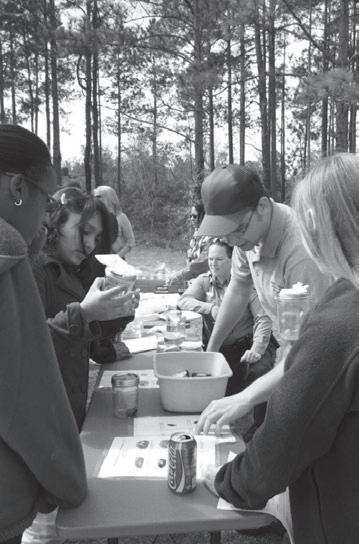
Through interactive training sessions, hands-on practice, and use of the teacher’s guide, students will learn marketable scientific skills, experience Lake Waccamaw and the Waccamaw River, and gain an appreciation of this globally important ecosystem.
N orth C aroli N a C oastal l a N d t rust is a N a CC redited o rga N izatio N !
After four years, the phone call we’d been waiting for finally came! “The Coastal Land Trust has been accredited,” we were told by an official with the Land Trust Accreditation Commission. With that, we became among the top 10% of the land trusts in the nation to be accredited.
Accreditation is more than a seal of approval by an independent agency. It gives land owners confidence that we’ll do the right thing and it shows our

donors and supporters how much we value their trust. It demonstrates that we’re a capable and reliable conserva tion partner.
Accreditation gives us something to show for all the boundaries we’ve marked, the places we’ve mapped and the documentation we’ve updated. Going forward, it will require us to build our endowment, so that we can steward our conservation lands in the future.
And it’s a reason to celebrate! Along with our 20th anniversary, and saving almost 50,000 acres, accreditation tells a great story about our accomplishments. It’s a pat on the back for long-time members, who can be proud of the organization they have nurtured and supported for so many years.
VOLUME 12 ISSUE 1 SPRING 2012
Board of directors
Board members serve three (3) year staggered terms. Board members are elected each year by the membership during the annual meeting.
PrESIdEnt
Linda Murchison Wilmington, NC
VIcE PrESIdEnt Kevin Hicks Wilmington, NC
Samuel B. Dixon Edenton, NC
Noel Fox Wilmington, NC
Jwantana G. Frink Southport, NC
Chandra Hawkins Columbia, SC
Paul Hosier Wilmington, NC
Don E. Hoss Beaufort, NC
staff
Main Office
131 Racine Dr., Suite 202 Wilmington, NC 28403 (910) 790-4524 (910) 790-0392 Fax
Camilla M. Herlevich Executive Director
John Napiecek Business Manager
Nancy Preston Outreach Coordinator
Jesica C. Blake Director of Stewardship
Cassie Gavin Land Protection Specialist
Jennifer Avesing Stewardship Biologist
Vann Pearsall Director of Development
Beth W. Steelman Development Associate
SEcrEtary
Edward Norvell Ocracoke, NC
trEaSUrEr Sadie Price Wilmington, NC
David Huffine Wilmington, NC
Donna Moffitt Kure Beach, NC
Ken Shanklin Wilmington, NC
Elizabeth Powell Storie Manteo, NC

John W. Thomas Rocky Point, NC
Clark Wright New Bern, NC
New Bern Office 3301-E Trent Road New Bern, NC 28562 (252) 634-1927 Phone (252) 633-4179 Fax
Janice L. Allen Deputy Director
Elizabeth City Office 11108 W. Main Street Elizabeth City, NC 27909 (252) 335-9495
Lee L. Leidy NE Region Director Attorney at Law
P reside N t ’ s M essage
C elebrating 20 Y ears !!
Congratulations to the North Carolina Coastal Land Trust (NCCLT) for 20 years of vision and commitment to the protection and preservation of open spaces and natural areas, conservation education and land stewardship throughout the entire coastal region of North Carolina –beaches, river corridors, islands, farms, forests, marshes, savannahs, public parks, our beloved long leaf pine and venus fly traps. This is huge mission with much more to be done. But on this 20th anniversary, I would like to take this oppor tunity to say THANK YOU!
Thank you to the dedicated and hard working staff, particularly Camilla Herlevich, founder and executive director. NCCLT has truly benefited from having a faithful staff that has been with it for a combined total of 86 years.
Thank you to the many partners – landowners, donors, state and federal agencies, non-profit or ganizations, private businesses – without whom NCCLT’s work and accomplishments would not be possible.
Thank you to the hundreds of volunteers who are actively engaged in efforts to protect this beautiful coast. You all “make it happen,” and we could not do this work without you.
Since the last newsletter we have been busy! Successful accreditation with the Land Trust Alliance; 423 new acres under conservation pro tection, including a watermelon farm in Carteret county; community outreach events in Wilming ton – Fly Trap Frolic, and in New Bern – Cyclists Going Coastal; and 3 “house parties” (though they’re not always at someone’s house!) to intro duce new people to the Land Trust.
Looking ahead, we hope you will join us for our 20th Anniversary Celebration on September 20th, 6:00 PM, on the Intracoastal Waterway, in Wilmington.
Again, on behalf of the Board, we thank you for all the ways you support this work. We look for ward to the next 20 years of working together.
d ire C tor ’ s M essage
F eeling g ood a bout l and C onservation
When our name is called in recognition of our Accreditation at the Land Trust Alliance Rally in Utah, we will have a small contingent there to receive this prestigious accomplishment. The rest of the people who truly made this possible are the members, donors, volunteers and staff that have supported the Coastal Land Trust in so many ways over the years.
I’d like to take a moment to recognize some of the people and institutions that were integral to this achievement. Special thanks to:
• All the staff, notably Cassie and Jesica, who got us in compliance, and then documented it all.
• Kimberly Shriner, our grad student Accredita tion Intern, who put it all together.
• Michael Murchison, the Board member on our internal Accreditation Committee and all the Board for its support – day in and day out.
• Alice Kirby Horton and the FM Kirby Foun dation, for generous annual grant support for capacity building work over the past few years, and for a special grant that covered the cost of the accreditation application.
• The Z. Smith Reynolds Foundation, for a grant several years ago to upgrade our stewardship program.
• The Cannon Foundation, for a grant to buy the equipment needed to secure our files and digitally store information.
• The Conservation Trust for NC and the Land Trust Alliance, for a grant in support of accreditation.

• And most especially, to Fred and Alice Stan back, for their continued generous support of our operations budget.
P eo P le i N the N ews
John thomas
Board member John Thomas’ champion retriev ers continue to win national and regional awards in field competition. Congratulations to him and to trainer Andrea Meisse.
Kevin Hicks
Kevin Hicks, Vice President of the Board of Director of the Coastal Land Trust, has been named Chief Financial Office of McGeever LLC of Cary, NC, a company that provides investment and investment analysis for medical device and healthcare businesses.
Jennifer rogers
Jennifer Rogers, Stewardship Biologist, married fellow conservationist Kyle Avesing in October.
Kristen Howell
The staff and Board of the Coastal Land Trust wish Kristen Howell a fond farewell as she moves with her family back to their home state Vermont. Kristen had been with the NC Coastal Land Trust for almost 4 years and worked on the Green Growth Toolbox project and the Waters of Waccamaw project. Kristen, we wish you the very best!
VOLUME 12 ISSUE 1
coastal laNd trust statistics
Nc
Acres Protected 48,000 Acres Household Memberships 2093 EMaIL info@coastallandtrust.org wEbSItE www.coastallandtrust.org
Composition & Printing By: Linprint Company, Wilmington, NC 2
Pre-Press
l ivi N g s horeli N e at s P ri N ger ’ s P oi N t
A “living shoreline” has been created at the Coastal Land Trust’s Springer’s Point Preserve to help reduce the erosion that has occurred at the Point. In order to better educate our members and visitors, we have compiled a list of frequently asked questions. We hope that this will help visitors under stand the work that has been undertaken at the Preserve.
What is the Coastal Land Trust doing at Springer’s Point Preserve?
The Coastal Land Trust contracted with the North Carolina Coastal Fed eration (NCCF) on the design and implementation of a natural shoreline restoration project (also known as a “Living Shoreline”) for the Preserve.
Why has the Coastal Land Trust planned a “Living Shoreline” restoration project at its Springer’s Point Nature Preserve?
Since Coastal Land Trust purchased the property in 2002, the Preserve has experienced extensive wind and wave-driven erosion of its Pamlico Sound beach and Old Slough shoreline.
Why is Springer’s Point worth saving?
Springer’s Point is an ecological gem, recognized by the N. C. Natural Heritage Program as a natural heritage site of statewide significance. It is culturally significant and it receives thousands of visitors annually. The Coastal Land Trust purchased its 122-acre Springer’s Point Preserve to protect its existing maritime forest and coastal marsh as well as its recre ational and cultural values. Areas that are now eroded previously served as important buffer to the maritime forest, and they were widely utilized by Preserve visitors. Unfortunately, the shoreline at the Preserve does not func tion like a natural shore system, which “rolls back” with coastal storms and then re-builds over time. This is due to the fact that the Preserve’s shoreline had previously been altered by a jetty and concrete rip-rap, and because ad joining developed properties prevent roll back and re-building. As a result, areas behind and south of the old concrete rip-rap became scalloped out and eroded.
What is involved in the project?
The project focuses on restoring approximately 500 feet of shoreline along the Old Slough side of the Preserve and is a demonstration project. An oys ter bag sill is placed offshore and parallel to the existing marsh to create a living breakwater, which allows the natural aquatic ecosystem to form. The marsh between the oyster bag sill and the shoreline is then planted with native marsh grasses. The goal is that the shore will buffer the wind and wave-driven erosion so that the shore can accrete and build naturally. Com munity partners assisted with the project, and local fisherman bagged the oyster shells and built the oyster bag sill. The Coastal Land Trust and NCCF also recruited volunteers from local schools and the community to assist with the planting of marsh grass.
What about the existing “jetty”?
Decades before the Coastal Land Trust purchased Springer’s Point Preserve, a prior owner deposited huge slabs of concrete, debris, and rubble along the “Point” where Old Slough flows into the Pamlico Sound and extended a jetty from the Point. The NC Division of Coastal Management (DCM) and NCCF Coastal Scientists have recommend breaking up the existing concrete slabs and rubble into smaller pieces and returning these to the existing footprint to more effectively buffer wave action. Therefore, at the same time that the Living Shoreline was being created along Old Slough, maintenance work was being carried out on the jetty and adjacent shore area by local contractors from Hatteras and Wanchese.

Why not just let nature take its course?
The Coastal Land Trust prefers to keep natural shorelines natural; however, because it “inherited” the modified Springer’s Point shoreline when it pur chased the Preserve, it is now tasked with the stewardship of the Preserve to maintain its conservation values. The Coastal Land Trust and NCCF have determined that the Living Shoreline is the most ecologically-sensitive shore line restoration option available. It has been successfully utilized in other areas by NCCF, including other conservation lands, such as Jockey’s Ridge State Park and Hammocks Beach State Park. Additionally, the Coastal Land Trust believes that the Living Shoreline demonstration project will be an excellent and visible environmental education tool to foster an appreciation of natural shoreline restoration (as opposed to building a bulkhead) and the important functions of marsh habitat.
Was a Coastal Area Management (CAMA) permit required for the Old Slough shoreline restoration project?
No. The state advised the Coastal Land Trust that no permit is required since the work being planned is considered to be maintenance work.
Has this type of restoration work been done before?
Yes. The Coastal Federation has completed over 19“Living Shoreline” projects along the coast. These Living Shoreline projects incorporate bio-en gineering techniques to avoid a “hardened” shoreline (e.g., bulkheads) and generally include combining stone, oyster shell, bio-logs or other structures with marsh plantings.
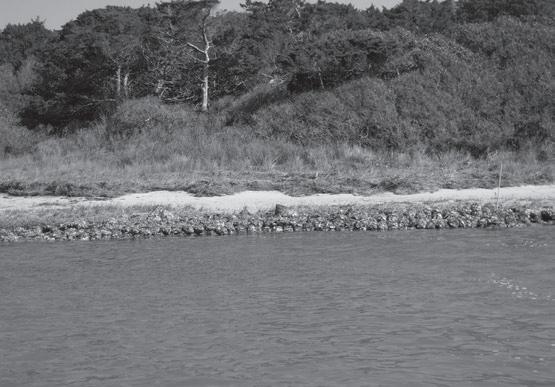

How was the project funded?
The primary funder of the Old Slough work was the U.S. Fish and Wildlife Service, which reviewed the project and awarded the Coastal Land Trust a grant to proceed. Funding for the jetty maintenance work is being provided by a separate federal grant awarded to NCCF and by private donations to the Coastal Land Trust for this purpose. You can support Springer’s Point by designating a special donation, or contacting Vann Pearsall, (910) 790-4524 x210.
Who can I contact to get more information about this project?
Contact Lee Leidy at 252/335-9495 in the Elizabeth City Office.
VOLUME 12 ISSUE 1 3
Staff Photo Staff Photo
Staff Photo
B reaki N g N ews for the “ w aters of w a CC a M aw
The Coastal Land Trust has been selected to receive a total of $1,000,000 as part of the settlement of a federal court case brought against a corporate hog farm for violation of the Clean Water Act. The violation stemmed from the discharge of hog waste into a tributary of the Waccamaw River in Columbus County. The Coastal Land Trust will receive five yearly installments of $200,000 per year beginning in 2013; funds are to be used to protect and preserve wetlands close to the properties impacted by the discharge in the court case.
The Waccamaw River is a conservation priority for conservation in North and South Carolina be cause of its nationally-significant natural areas, its beautiful undisturbed swamp forests, and its fascinating history. In 2007, the Coastal Land Trust protected 3 miles of frontage on the Waccamaw, including cypress gum swamplands and stands of Atlantic white cedars.

“This award by the court gives us an opportunity to conserve more land along the Waccamaw,” said Camilla Herlevich, Executive Director of the Coastal Land Trust. “We are grateful that the US Attor ney recommended us to the court, and we look forward to playing a useful role in protecting lands along the banks of the Waccamaw in the years to come. The Waccamaw is a truly special place.”
w el C o M e & s P e C ial t ha N ks to v olu N teers l eaders
Donna Moffitt, who recently retired as Director of the North Carolina Aquarium at Fort Fisher, has joined the Board of Directors of the Coastal Land Trust. Trained as an attorney, she served as Director of the NC Division of Coastal Management and has held numerous positions in environmental protection agencies. She is a recipient of the Order of the Long Leaf Pine. Donna and her husband Tom Moffitt live in Kure Beach and enjoy snow skiing, scuba diving and kayaking.
Paul Hosier, phD. is professor of biology at the University of North Carolina at Wilmington and has held several administrative positions there, most recently Provost and Vice Chancellor for Academic Affairs. A coastal plant ecologist, Hosier has more than 40 years of research experience along the Atlantic barrier islands from Cape Cod, MA to Padre Island, TX. He is currently working on a guide to plants of the coasts of North and South Carolina.
The Coastal Land Trust is also pleased to welcome several new Committee Members. Harrison Marks of Winston-Salem, Chad Pearson of Wilmington, and Terry Tait of New Bern have joined the Finance Com mittee. George Bland, Jesse Powell, Cris Point and Katherine Cammack, all of Wilmington, have joined the Development Committee. Richard LaBlond of Richlands and Jeannie Cariker of Wilmington have joined the Land Protection Committee.
Donna Moffit joined the NCCLT Board of Directors.
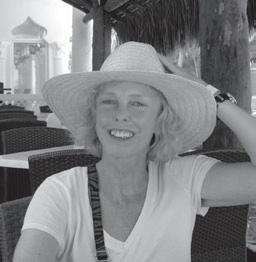

Paul Hosier, phD.
Specialty plates are a great way for residents of the state to show their support for the Coastal Land Trust while helping us raise awareness of our organization. For each plate purchased, the land trust will receive $20 to support our work in the coastal plain of North Carolina. This is a great opportunity for the land trust to create a sustainable revenue stream that has potential, based on our research, to contribute between $50,000 and $100,000 to our budget annually!
In order to produce the plate, we must collect 300 applications, with the $30 plate fee, from NC residents who currently have vehicles registered with the DMV and are willing to purchase the specialized plate. Personalized plates are also available for $60 (up to four spaces).
To sign up to be a proud owner of the new Coastal Land Trust license plate, please contact Vann Pearsall (910) 790-4524 x210, or download the form from our website, www.coastallandtrust.org, and mail it in! The sooner we reach 300 the sooner they’ll be on the road!

4 VOLUME 12 ISSUE 1
”
s ig N u P for a C oastal l a N d t rust l i C e N se P late ! Staff Photo
l a N d P rote C tio N a CC o MP lish M e N ts
contentnea creek/ bray Hollow tract, Phase 2
In December, the Coastal Land Trust completed its second conserva tion easement at Bray Hollow on Contentnea Creek in Pitt County. This 116-acre parcel adjoins a 102-acre tract, which was protected in 2008. The owners, John and Nancy Bray of Ayden, donated perpetual conservation easements over both parcels. This property includes productive farm land and woodland, and an extensive forested buf fer along Contentnea Creek and its tributaries. The conservation easement allows Dr. and Mrs. Bray to continue using the land for environmental education, but prohibits development and protects the wildlife, water quality, and agricultural productivity of the property. (John and Nancy Bray are profiled on page 7)
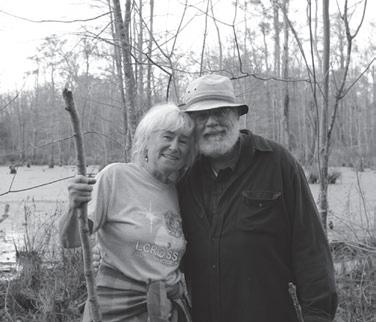
North Carolina Coastal Land Trust received a $25,000 grant from the Clean Water Management Trust Fund to offset the transaction ex penses (survey, title examination, title insurance, recording costs, and stewardship endowment) for this acquisition.

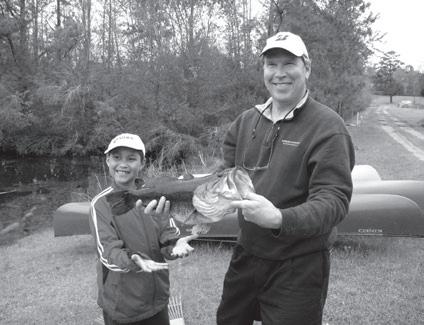
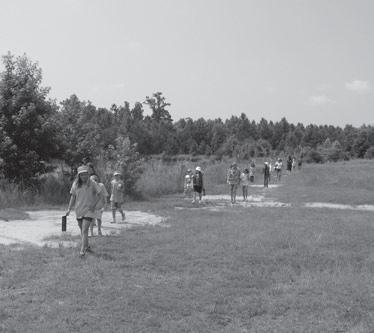
boiling Spring Lakes / corbett Industries tract
The Coastal Land Trust assisted the State of North Carolina in its acquisition of a 69-acre tract just outside the Town of Boiling Spring Lakes in Brunswick County in November. The Coastal Land Trust received a generous acquisition grant of $114,000 from Fred and Alice Stanback of Salisbury NC, which we provided to the State, so that it could purchase the tract from Corbett Industries and add it to the Boiling Spring Lakes Plant Conservation Preserve. The Pre serve is designed to protect a group of imperiled and rare plant species, including the Venus flytrap and the rough-leaf loosestrife, both of which are known to occur in the area along with other rare plant and animal species. The tract protected is part of a larger 275 acre property targeted for conservation. It is bounded on two sides by other state holdings and is a priority of the Plant Conservation Program and the NC Heritage Trust Fund. The State has an option to purchase the remainder of the 275 acre tract.
Pettigrew State Park / Patrick tracts
North Carolina Coastal Land Trust was pleased to assist the State of North Carolina acquire a 188.86-acre addition to the Pettigrew State Park in Washington County in December. The State’s purchase was funded by the Parks and Recreation Trust Fund, the Natural Heritage Trust Fund and the Coastal Land Trust. The Coastal Land Trust was able to contribute to this purchase thanks to a generous donation from Fred and Alice Stanback of Salisbury, NC. The land protected lies along the Scuppernong River and includes almost a mile of river frontage. The Scuppernong River Corridor is designated as a Nation ally Significant Natural Heritage Area which hosts rare plants and animals. The property will become part of the Scuppernong River Section of the Pettigrew State Park. Adjacent to the Park, the US Fish and Wildlife Service manages 3,214 acres along the river as part of the Pocosin Lakes National Wildlife Refuge.
Guthrie Farm
Home to the Carteret County’s famous Bogue Sound Watermelon, Guthrie Farm’s 50 acres are now protected. The Coastal Land Trust worked with its long-time partner, the US Marine Corps at Cherry Point, whose interest is to buffer the strategically important Bogue Landing Field from incompatible development. The Guthrie Fam ily retains title to their family farm, but it is now under perpetual conservation and restrictive easements. Funding for the project was provided by the Department of Defense, the NC Atttoney Genr’s Environmental Enhancment Trust Fund, and the NC Agricultural Development and Farmland Preservation Trust Fund.
Guthrie Farm watermelon stand.
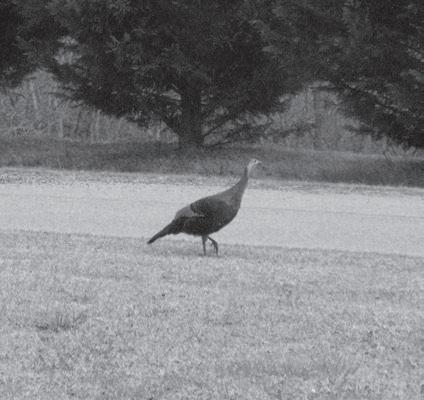
The turkey population is growing on the Bray property.
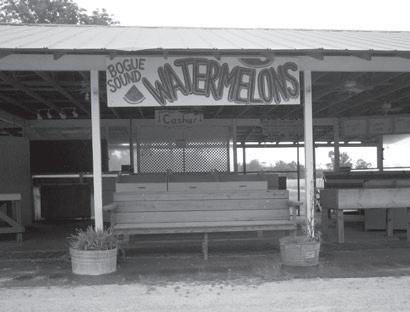
VOLUME 12 ISSUE 1 5
Girl Scouts in grassland habitat after complet ing merit badge project and nature walk on Bray property.
ECU Fraternity helping with beaver dam control on Martin Luther King, Jr. Service Day at Bray property.
Father and son with their biggest catch ever from the Bray’s property.
Nancy and John Bray at their favorite spot on the Cypress Swamp.
Photos provided by John & Nancy Bray
s P e C ial e ve N ts
tidewater Members receive Special “Love day” treatment



The Coastal Land Trust’s We Heart Tidewa ters membership event brought together more than 25 major Land Trust contributors on February 11, for an evening of wine, food, and great conversation. The Tidewater “Valentine’s Day” reception was held at the C. W. Worth House, one of Wilmington’s oldest B&Bs, with hosts and innkeepers Margi and Doug Erickson.
In addition to their love of the land, Tidewa ter members find that they often have a lot in common. In fact, in getting to know each other, two couples found they had lived in the same location many years ago and had memories to share. Talk about one degree of separation!

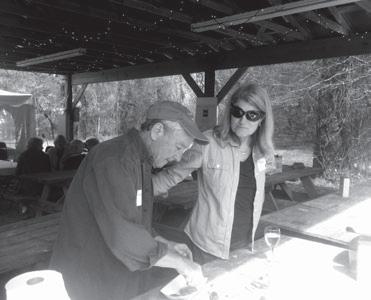

The Orton Foundation sponsored the recep tion and a real treat was having Dillon Epp and his wife Jessica attend. Dillon is the property manager at Orton and is oversee ing the restoration of the longleaf pine forest, the removal of invasive species that have overrun the plantations’ rice fields and preservation of the plantation’s historic house and gardens.
Tidewater Society members are the leading benefactors of the Coastal Land Trust. With their commitment to give $1000 or more in a single year to support the annual fund, their donations are leveraged exponentially to attract competitive grants to purchase land and easements. For more information about becoming a Tidewater member, contact: Beth White Steelman, 910-790-4524, ext. 200 or bsteelman@coastallandtrust.org
clambake for the coastal Land trust at the beaufort arts center
Artist Sally Anger, joined by John Fussell & Marta Pearson, Bruce and Regina (Pudge) McCutcheon, Sunny Newton, Ann & Bland Simpson and Carl Spangler & Gayle VanVel sor hosted a clambake dinner and fundraiser at the Beaufort Arts Center in historic down town Beaufort on Saturday February 18th. We made some great new friends among Beaufort’s many conservation-minded and fun-loving residents, and hope to repeat the occasion next year.
Field day at Five Eagle Farm
More than 60 members and friends came out to Rocky Point for our annual Field Day and Oyster Roast, and while the rain may have kept some away, those that braved the elements were treated to a great day of food, fellowship and fun at Five Eagle Partners Farm. Hosts John and Judy Thomas made sure everyone had an enjoyable time. The rain let up just long enough for the retrievers to showcase their skills, the quail hunt demonstration, and a very informative tour of the farm.
Party for the Point on Ocracoke
The beautiful Ocracoke home of Ed and Susan Novell was the scene of a party to benefit the Coastal Land Trust’s Springer’s Point Preserve. About 40 friends and neigh bors of the Norvells joined local Preserve Manager Len Skinner, and staffers Lee Leidy and Camilla Herlevich for an evening of great camaraderie and delicious food from The Flying Melon. More than $5,000 was raised, all of which will support stewardship at the Preserve.
Development 4% General Admin 0% Stewardship 4% Conservation Planning 1% Education 3% Land 88%
Peggy Turner works with her companion dog dur ing the Field Day at Five Eagles Farm.
VOLUME 12 ISSUE 1 6
The clambake dinner & fundraiser was held at the Beaufort Arts Center on February 18th.
Government 2% Other 14% Contributions & Member Support 84% Federal 22% State 46% Members & Corporate 32% ExpEnsEs OpErating incOmE land grants f i N a NC ial s u MM ary October 1, 2010 through September 30, 2011
Cay & Michael Davis helping out at the Field Day at Five Eagles Farm.
B ri N gi N g k ids B a C k to N ature
John and Nancy Bray, of Ayden N.C., have a very special purpose in mind when they preserve land. They are the founders of A Time for Sci ence, a hands-on, site-based nature and science learning center that brings students and families out to learn about the envi ronment we live in. Both are former educators who were dissatisfied with the way schools taught science and were looking for a way to engage students in nature and science while making it fun for the kids to learn. Nancy taught science in the public school system and John retired from East Carolina University’s Brody School of Medi cine.
“We live in an area where the science test scores are in the bottom third of the state, which is in the bottom third of our country, which is in the bottom third of the world,” says John.
The property is a living blackboard, full of lessons that illustrate the importance of learning by doing. The programs and camps offer an environment where visitors can be engaged in and experience both environmental awareness and the scientific method. Standing by her organic garden, Nancy explains how the hand pump is used to teach the importance of clean water to kids, many who think water just comes from the tap. While touring the new center, a surplus double wide donated by Pitt County, John talks about the newly installed septic tank, which will allow researchers to monitor the groundwater in an effort to collect data to research pollution from septic tanks compared to the chemicals used in farming.
The program is their “retirement dream,” but they credit their vol unteers, educators from East Carolina and Pitt County Community
College, and the Pitt County Soil and Water Conservation Depart ment for truly making it a reality. Working with Pitt County and the Boys and Girls Club, the Brays bring hundreds of students out to learn about the wonders of nature – from building telescopes to lay ing out a scale model of the solar system – in both planet size and distance (Pluto is about 1/4 mile from the sun, down the road and around the corner).
“In 2004, Nancy and I moved to Contentnea Creek Estates (in Ayden, just south of Greenville). As long-time supporters of the NC Nature Conservancy and with an interest in the North Carolina Land for Tomorrow program, we began to think about the possibility of re claiming some of this land from development and preserving it for the appreciation of nature. After a couple of years living there we started to acquire several of those parcels for conservation purposes and we began to work with the North Carolina Coastal Land Trust.” Since that time the Bray Hollow Conservation Ease ments have grown to 228 acres of protected forest and farmland that serve to inspire and challenge the students of eastern North Carolina.
For more information on the programs, camps and services offered at the center, visit www.atime forscience.org.

C oastal l a N d t rust r e C eives its f irst P la NN ed g ift
William (“Bill”) Joslin, noted conservationist, attorney, and North Carolina civic leader, died on January 28, 2011 at the age of 90 in Raleigh. He and his wife Mary Coker Joslin joined the Coastal Land Trust in 1994, and visited Lea Island and many other conservation lands protected by the Coastal Land Trust. Mr. Joslin’s daughter, Nell Joslin, contacted the Coastal Land Trust in February to advise that her father had included the North Carolina Coastal Land Trust in his will, and that we would be receiving a gift. The gift, which was very generous, was received this spring. “Bill Joslin was a wonderful men tor to a whole generation of conservationists,” said Camilla Herlevich, Executive Director of the Coastal Land Trust. “He and Mary are pas sionate about conservation and wildlife, which they demonstrate by the care they take in their own gardening and by their volunteer leadership in helping to save the state’s most significant conservation lands, from the mountains to the sea.” Mr. Joslin served as a Trustee on the N.C. Natural Heritage Trust Fund Board, the NC Chapter Board of The Nature Conservancy, and contributed to many different conservation groups in a variety of ways. The Joslins’ 4 1/4 acre gar den and homeplace in Raleigh will one day be a part of the Raleigh Parks system.
The William Joslin Bequest is the first planned gift ever received by the Coastal Land Trust, though more than 30 persons have notified the Coastal Land Trust of their intent to make a planned gift to ben efit the organization. Those who make planned gifts are recognized as members of the Coastal Legacy Society.
The Coastal Land Trust’s policy is to direct all planned gifts, unless the donor designates otherwise, to the Coastal Land Trust’s Steward ship Endowment, which is where the William Joslin Bequest has been deposited. The funds in the Stewardship Endowment may be used for monitoring and defending easements, and management of conservation lands held by the Coastal Land Trust. With almost 50,000 acres of land currently held in the portfolio of the Coastal Land Trust, there is a great need to increase the funding of the Stew ardship Endowment. For this reason, the William Joslin Bequest is a tremendously welcome gift to the Coastal Land Trust.
If you would like more information about the Coastal Legacy Society, and how to make a planned gift to the Coastal Land Trust, please contact Camilla Herlevich (910-790-4524, ext. 206 or camilla@coastal landtrust.org) or your own estate planning attorney.

VOLUME 12 ISSUE 1 7
131 Racine Drive, Suite 202 Wilmington, North Carolina 28403

































Whether your interests lie in the great outdoors or at the conference table, we have a volunteer op portunity for YOU! If you have volunteered for the Land Trust in the past and haven’t heard from us in a while, contact us so that we can confirm your contact information and find out what interests you most. If you have never volunteered for the Land Trust, and one of the above grabs your attention, don’t hesitate, call or email today. To learn more, contact: Beth Steelman at 790-4524 ext. 200 or bsteelman@coastallandtrust.org.

U
PaId
Permit No 316 SAVE THE DATE !
Nonprofit Organization
S Postage
Wilmington, NC
North Carolina Coastal Land Trust thanks these
C orporate S pon S or S Slick Enterprises
davis Hartman wright, PLLc
Opportunity Partner Point clan #1, LLc
Sugg, carmichael, Hicks & Hart, P.a
Stan white realty and construction, Inc.
timber
Sumrell,
Saturday, September 22nd 20th Anniversary Annual Meeting, Wilmington Saturday, October 13th Brunswick County Family Fun Day Visit the Coastal Land Trust website at www.coastallandtrust.org for more information on these upcoming events There’s a Place for You as a Land Trust Volunteer!


























































